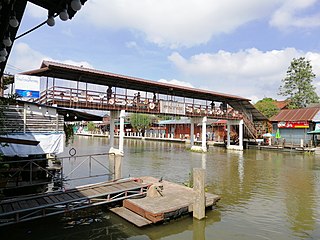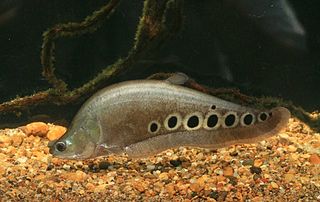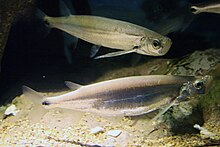
Thai cuisine is the national cuisine of Thailand.

The Mekong or Mekong River is a trans-boundary river in East Asia and Southeast Asia. It is the world's twelfth-longest river and the third-longest in Asia with an estimated length of 4,909 km (3,050 mi) and a drainage area of 795,000 km2 (307,000 sq mi), discharging 475 km3 (114 cu mi) of water annually. From its headwaters in the Tibetan Plateau, the river runs through Southwest China, Myanmar, Laos, Thailand, Cambodia, and southern Vietnam. The extreme seasonal variations in flow and the presence of rapids and waterfalls in the Mekong make navigation difficult. Even so, the river is a major trade route between western China and Southeast Asia. The construction of hydroelectric dams along the Mekong in recent decades causes serious problems for the river's ecosystem, including the exacerbation of drought.

Samut Songkhram is one of the central provinces (changwat) of Thailand.

The barramundi, Asian sea bass, or giant sea perch, is a species of catadromous fish in the family Latidae of the order Perciformes. The species is widely distributed in the Indo-West Pacific, spanning the waters of the Middle East, South Asia, Southeast Asia, East Asia, and Oceania.

The bluegill, sometimes referred to as "bream," "brim," "sunny," or "copper nose" as is common in Texas, is a species of North American freshwater fish, native to and commonly found in streams, rivers, lakes, ponds and wetlands east of the Rocky Mountains. It is the type species of the genus Lepomis, from the family Centrarchidae in the order Perciformes.

The walking catfish is a species of freshwater airbreathing catfish native to Southeast Asia. It is named for its ability to "walk" and wiggle across dry land, to find food or suitable environments. While it does not truly walk as most bipeds or quadrupeds do, it can use its pectoral fins to keep it upright as it makes a wiggling motion with snakelike movements to traverse land. This fish normally lives in slow-moving and often stagnant waters in ponds, swamps, streams, and rivers, as well as in flooded rice paddies, or temporary pools that may dry up. When this happens, its "walking" skill allows the fish to move to other aquatic environments. Considerable taxonomic confusion surrounds this species and it has frequently been confused with other close relatives. One main distinction between the walking catfish and the native North American ictalurid catfish with which it sometimes is confused, is that the walking catfish lacks an adipose fin.

The Mekong giant catfish, is a large, threatened species of catfish in the shark catfish family (Pangasiidae), native to the Mekong basin in Southeast Asia and adjacent China. It is considered critically endangered due to overfishing and habitat loss.

Wallago attu is a freshwater catfish of the family Siluridae, native to South and Southeast Asia. It is commonly known as helicopter catfish or wallago catfish. It has known by various names in different regions and languages, such as Borali (বৰালি) in Assamese, Tamil ஆத்துவாளை , Manipuri Sareng,Mizo:Thaichhawninu, the Odisha Balia (ବାଳିଆ), the Bengal Boal (বোয়াল), Vietnamese : Cá leo the Sylheti Gual or the Malaysian and Indonesian Tapah are also occasionally used in English. W. attu is found in large rivers and lakes in two geographically disconnected regions, with one population living over much of the Indian Subcontinent and the other in parts of Southeast Asia. The species can reach a maximum length of 2 m.

Pla ra, similar to padaek in Laos, is a traditional Thai seasoning produced by fermenting fish with rice bran or roasted rice flour and salt fermented in a closed container for at least six months. Fermented fish seasoning are commonly found in Cambodian, Lao, Mon, Thai and Vietnamese cuisine. Pla ra has a very strong smell, which is considered unpleasant by some people. Its flavors are salty and sour, depending on the amount of salt put in and lactic acid resulting from fermentation process.

The clown featherback, also known as the clown knifefish and spotted knifefish, is a nocturnal species of tropical fish with a long, knife-like body. This knifefish is native to freshwater habitats in Cambodia, Laos, Thailand, and Vietnam, but it has also been introduced to regions outside its native range. It is one of the world's most invasive species.

The Siamese mud carp is a species of freshwater cyprinid fish, a variety of Asian carp native to the Mekong and Chao Phraya Rivers in Southeast Asia, especially in Cambodia, Laos and Thailand. It is very common in floodplains during the wet season and migrates upstream in the Mekong starting in Cambodia.

Steamed curry is a Southeast Asian type of curry steam-cooked in banana leaves and served with cooked rice. In Laos, it is also roasted on embers. The base of the curry is made with a curry paste with or without the addition of coconut cream or coconut milk and eggs. A wide range of leaves and staple ingredients are also added to the dish, such as:

The bronze featherback is a ray-finned fish in the family Notopteridae found in South and Southeast Asia. Although primarily found in fresh water, it has been known to enter brackish water. At present, it is the only member of the genus Notopterus, but as currently defined, it is likely a species complex.

The Java barb, more commonly known as silver barb in aquaculture, is a species of ray-finned fish in the genus Barbonymus.

The short mackerel or shortbodied mackerel is a species of mackerel in the family Scombridae. Its habitat is the shallow waters of Southeast Asia and Melanesia, feeding mainly on small zooplankton. It is of major importance to the fisheries industry.

Shark minnow is a species of small cyprinid fish found in Southeast Asia from the Mae Klong River to the Mekong. It lives mainly in rivers, moving into flooded forests and fields during the floods and back into the river as the floods recede. It usually swims close to the surface in schools of many individuals. It is one of the most abundant of the different types of minnow-sized fishes known as pla sio in Thailand.

Tor douronensis, also known as Labeobarbus douronensis, is a species of ray-finned fish of the family Cyprinidae in the genus Tor. This Asian fresh water river carp can be discovered in southern Thailand, east to Vietnam and south to Indonesia. The species is known from the Chao Phraya and Mekong rivers.
This fish has been attributed to Valenciennes however, in his original notes, he claims that the fish he described "formed part of the collection made in Java by Kuhl and Van Hesselt; they named it Dourr." Certainly, the type locality is Java, in Indonesia and the holotype is lodged at Bogor Zoology Museum.

Phalacronotus bleekeri, commonly known as Bleeker's sheatfish, is a species of catfish of the genus Phalacronotus. This species grows to a length of 60 centimetres (24 in) SL.
Paralaubuca harmandi is a species of freshwater ray-finned fish from the family Cyprinidae, the carps and minnows from south east Asia. It occurs in the Mekong and Chao Praya in Thailand, Laos, Cambodia and Vietnam. It is a solitary species which is normally found as scattered individuals in the shallow and medium depths of large rivers. It feeds on zooplankton and insects of larger size than the other species in Paralaubuca. It moves into floodplains during the monsoon to feed and maybe to breed, and it has also been recorded undertaking short migrations upstream in rivers. It is fished for by both commercial and subsistence fisheries and it is processed into fermented products in Cambodia while elsewhere it is salted and dried. This species is rare in the aquarium trade.

Thale Noi Non-Hunting Area is a protected fresh water wetland located in Phatthalung province, southern Thailand. Covering an area of 460 km2, the wetlands are situated approximately 20 km inland from the east coast peninsula of the Gulf of Thailand and 115 km north of the Malaysian border in Satun province. Thale Noi Non-Hunting Area is one of the largest natural freshwater lakes in South East Asia. It is the smallest, northernmost basin in the chain of lagoons that form Songkhla Lake, spreading across three provincial boundaries into Nakhon Si Thammarat, Phatthalung and Songkhla provinces and is home to the critically endangered Irrawaddy dolphin.




















